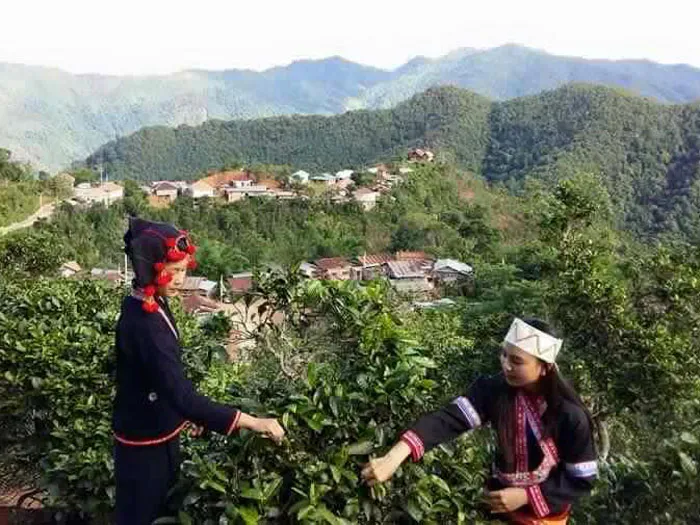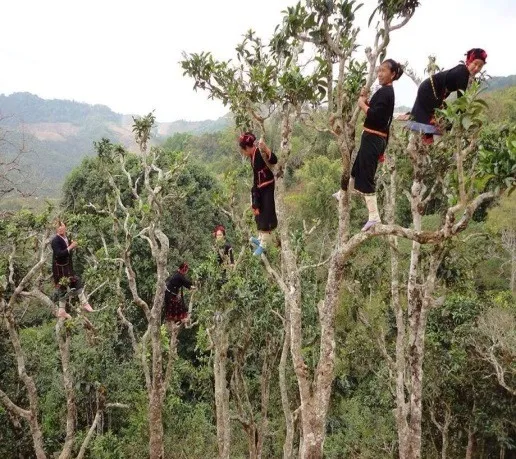Stepping into Phongsaly, the northernmost province of Laos, visitors are not only overwhelmed by the majestic beauty of the mountains but also amazed by the endless green tea hills. Here, nestled among peaceful villages, the 400-year-old Tra Co tea plantation stands as a historical witness, telling the story of Phongsaly’s land and people through each cup of tea imbued with the flavor of time.
Tra Co Phongsaly Tea Plantation: A Unique Green Tourist Destination
Tra Co Tea Plantation is located in Komen village, a small and beautiful village about 15km west of Phongsaly province center. With a vast area of 32.25 hectares and nearly 50,000 ancient tea trees, this place is not only a source of livelihood for local people but also an attractive ecotourism destination, drawing visitors with its pristine beauty, tranquility, and unique cultural experiences.
Coming to Tra Co Tea Plantation, visitors will immerse themselves in the green and fresh space of endless tea hills. Ancient tea trees with rough, mossy trunks, bearing the marks of time, create a scene that is both ancient and poetic. Strolling among the lush green tea rows, inhaling the mild fragrance of young tea leaves, listening to the birds singing, all the worries and anxieties of life seem to vanish.

Not only admiring the natural beauty, visitors also have the opportunity to learn about the traditional process of planting, caring for, and processing tea by local people. From picking fresh young tea buds in the early morning, wilting them in the sunlight, to the meticulous step of roasting tea over a fire, each step contains dedication and experience passed down through generations.
The 400-Year Journey of Tra Co Tea Plantation
Tra Co Tea Plantation is not just a tourist destination, but also a precious cultural and historical heritage of Phongsaly. According to research and local stories, this tea plantation is over 400 years old, formed in ancient times and closely linked to the development of this land.
The ancient tea trees here are living proof of the plantation’s long history. Some tea trees have large, rough trunks, up to a meter in diameter, requiring several people to embrace them. Through historical ups and downs, these tea trees still thrive, reaching for the sun and wind, producing high-quality tea buds.

The existence and development of Tra Co Tea Plantation over the past 400 years not only demonstrates the resilience of nature but also shows the close connection between people and tea trees. Tea is not only a crop that brings income but also an indispensable part of the cultural and spiritual life of the people of Phongsaly.
Unique Travel Experiences at Tra Co Tea Plantation
Traveling to Tra Co Tea Plantation offers visitors unique and unforgettable experiences. The best time to visit the tea plantation is from February to April each year. This is the tea season with the best quality, and also the time when the tea plantation shows off its freshest, most vibrant green.
Here, visitors can participate in many exciting activities:
- Hiking: Explore winding trails through the tea hills, enjoy the fresh air, and admire the beautiful natural scenery.
- Visiting tea processing workshops: Learn about the traditional tea processing, from picking, wilting, roasting to packaging.
- Enjoying tea ceremony: Sitting in the green space of the tea plantation, enjoy delicious, rich Phongsaly tea, feeling the quintessential flavor of heaven and earth.
- Cultural exchange: Learn about the life, customs, and traditions of local people, listen to stories about the history and culture of Phongsaly tea.
- Shopping for specialties: Buy genuine Phongsaly tea products as gifts for family and friends.
Tra Co Tea Plantation is not only an ideal destination for nature lovers but also a place for visitors to learn about the unique tea culture of Laos.
Economic and Cultural Value of Phongsaly Tea
Phongsaly tea has long been famous as a specialty of Laos, highly appreciated for its quality and flavor. Thanks to favorable natural conditions and long-standing tea growing experience, Phongsaly tea has a rich, distinctive flavor, different from other types of tea.
To meet the increasing demands of the market, Phongsaly tea has been exported to many countries around the world, including China and Germany. Each year, dozens of tons of Phongsaly tea are exported, bringing significant income to local people. According to statistics, each tea-growing household in Komen village has an average income of about 20 million Kip per year, thereby improving the lives of local people.
Not only having economic value, Phongsaly tea also carries deep traditional cultural values. Tea trees are closely associated with the lives of Phongsaly people, from daily meals to traditional rituals and festivals. Drinking tea is not just a habit but also a characteristic cultural feature, showing the hospitality and sincere affection of the local people.
Conclusion
Tra Co Phongsaly Tea Plantation is a unique and attractive tourist destination, possessing pristine natural beauty, long-standing cultural history, and great economic value. Coming to the tea plantation, visitors not only admire the beautiful scenery and enjoy the delicious tea flavor but also have the opportunity to learn about the culture and life of local people. If you have the opportunity to visit Laos, do not forget to take the time to explore Tra Co Phongsaly Tea Plantation, to fully appreciate the beauty and value of this 400-year-old treasure.